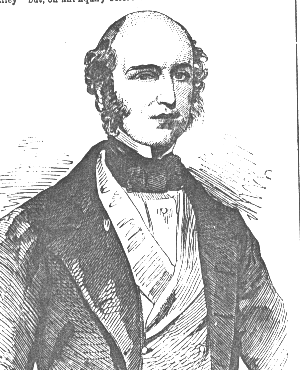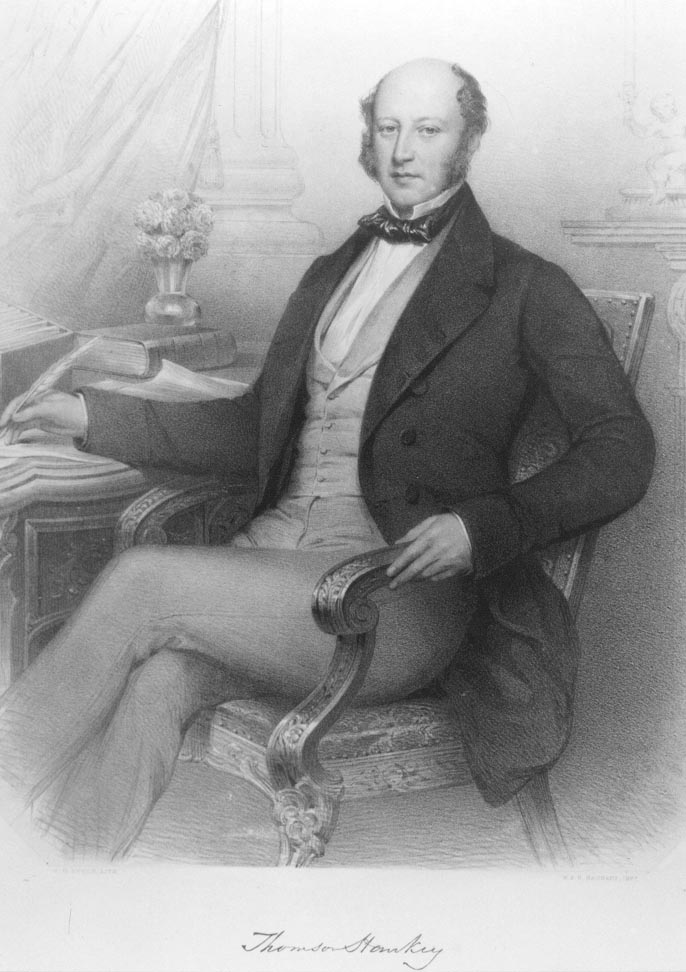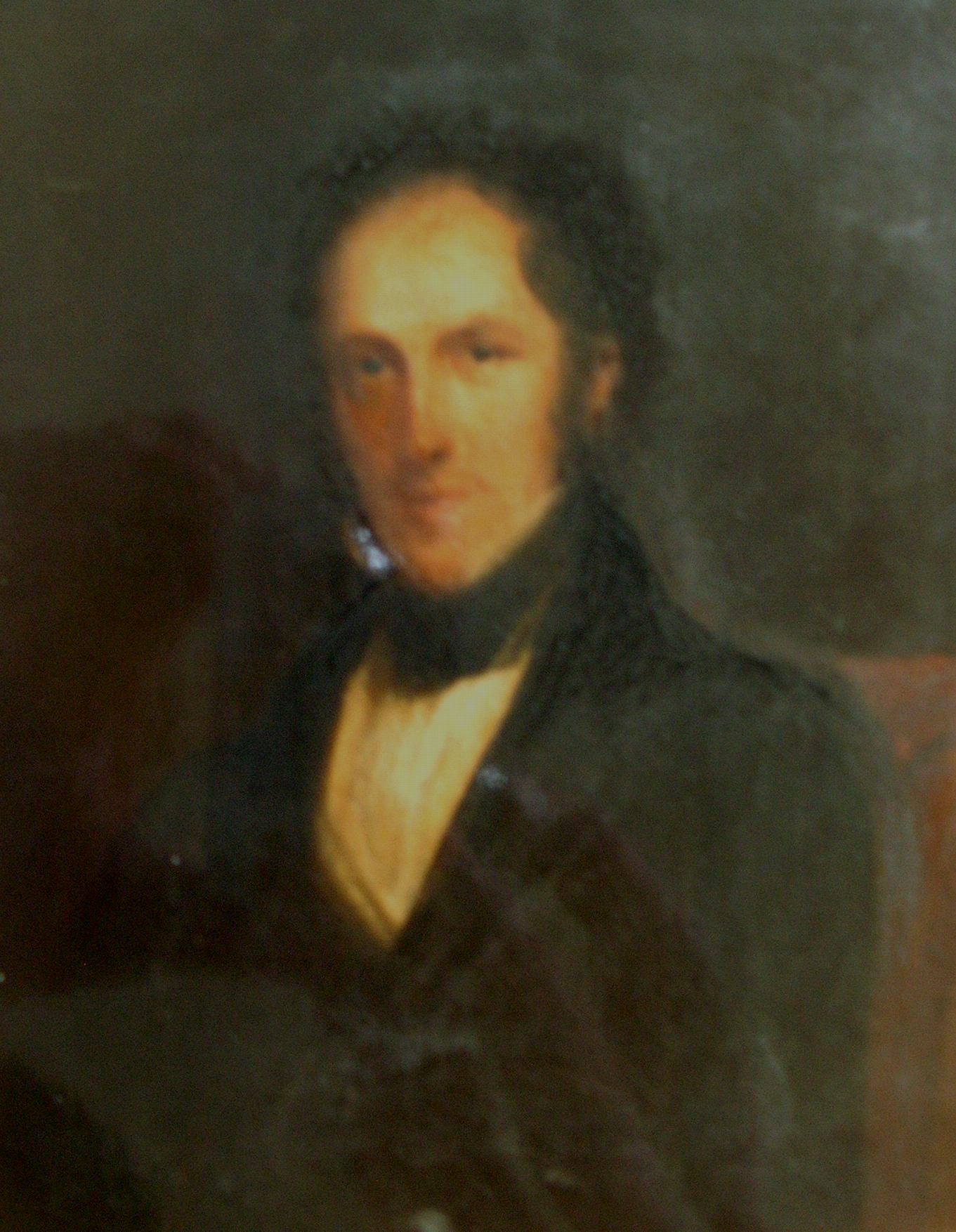Navigation: Hankeys of Churton > John Hankey > Robert Hankey > Robert Hanky > Thomas Hankey > Henry Hankey > Thomas Hankey > John Hankey > Thomson Hankey >
Thomson Hankey (1805-1893)
Eldest son of Thomson Hankey of Mincing Lane, Thomson was born on 5 Jun 1805 at Dalston and baptised on 13 Jul at Hackney, St John.
He was married on 4 Feb 1830 to Apolline Agatha Alexander. She had been born on 15 Oct 1807 at Calf Pasture, Augusta Co., Virginia, daughter of William Alexander, and half sister of John Peter Hankey’s wife Isabella. She had been orphaned and subsequently raised by Mrs Thomas Biddle.

Thomson Hankey, MP

Partner (senior partner 1857) in his father’s firm of Thomson Hankey & Co., West India merchants. Sailing their own small fleet of schooners, the firm brought their produce back to London, amongst other things sugar, nutmeg and cocoa. Anxiety was felt as Derby Day drew near, for if the weather was not ‘set fair’, the returning ship, carrying a large consignment of coconuts, could be late, with the certainty of great wastage and loss of money.
The firm’s fleet of schooners included the Caroline, 323 tons, built at Blackwall in 1841; the Ellen in 1841; and in 1863/4 the Foster, Apolline, Wentworth and Peterborough (all of these names having family connections).
There was also the Helen in 1839 and the Thomson Hankey (682 tons fully rigged) built 1853. The Balcombe was the last vessel which Thomson Hankey owned, and she was nick-named The Chocolate Girl; she had been launched in 1861 with a dead weight of 359 tons, and was lost just before the end of the century. At this time, the firm’s uniform had buttons with a dark blue H set in white with a dark blue edge. Thomson was also in business as a sugar broker, under the name Hankey, Plummer & Wilson, of 7 Mincing Lane.
Thomson Hankey was a director of the Bank of England 1835-93, deputy governor 1849-51, governor 1851-53; director of the Guardian Assurance Company 1837-91; a commissioner of Public Works Loans. Liberal MP for Peterborough 1853-68 and 1874-80. In the House of Commons he spoke frequently on financial subjects, and after the commercial panic of 1866, criticised the constitution and action of the Bank of England. A Commissioner of Lieutenancy for London; JP for Middlesex and Kent. Member of Political Economy Club 1855-77; he collected tracts on financial topics, many of which he gave to the City Liberal Club; author of many works, including The Principles of Banking: Its Utility and Economy, 1866. FRGS.
In 1857 a serious financial crisis caused the bankruptcy of a dozen American railroads. The American financier George Peabody had made his fortune by creating and maintaining a market for American securities, and his firm now had to maintain confidence by buying back those securities. George Peabody was faced with ruin, but his ‘many years of cultivation of friendship saved the firm. In 1834 he had made friends with young Thomson Hankey, Jr., on a ship travelling from America to England. Hankey had married an American girl, and the friendship had grown closer. Now, in an unprecedented action, Governor Thomson Hankey, Jr., of the Bank of England, authorised the lending of a million pounds to George Peabody and Company.’ Confidence was restored by this huge loan, and George Peabody was saved.
Thomson Hankey had a house at Hornsey in 1831, and was living in 1839 at Tring Park, a fine mansion built by Charles II for Nell Gwynne. He later lived at 59 Portland Place (which had previously been a home of Frederick Alers Hankey’s father in law TJ Miller, MP) and at Shipbourne Grange, near Tonbridge.

This portrait, by an American artist named Ramm, is probably of Thomson Hankey Jr (1805-1893), who married an American wife in 1830 (compare the hairline with the portrait above).
It is also suggested it could be of his father, Thomson Hankey Sr (1773-1855) or even of Thomas Hankey (1791-1879).
Thomson and Apolline entertained extensively, and Thomson wrote a lengthy article dealing with ‘London Dinners’, which was published in Macmillan’s Magazine. He stresses the point that wit and intellectual conversation are of paramount importance, with food coming second. He disapproves of the number of guests exceeding twelve or fourteen, and considers that 1-1½ hours should be the time-limit ‘ it was common in those days to invite twenty-four people to a private dinner lasting two hours or more. ‘Wax candles are essential’ writes Thomson, ‘gas light is intolerable, and oil lamps smell.’
He would like the Nation rescued from that slur cast upon it by foreigners, that ‘the English prefer quantity to quality.’ A French friend once remarked to him: ‘En Angleterre on se nourrit bien, mais on ne dine pas.’
Both Thomson and Apolline were keen travellers, and as his younger brother George used to take his carriage and pair by steamer across the Channel, probably Thomson did so, too. One of his favourite countries was Austria, and he steeped himself in its history, finding the reign of the Empress Queen Maria Theresa particularly fascinating; so much so, that he delivered an historical lecture on the subject in his constituency of Peterborough in 1859.
Thomson and Apolline were disappointed in having no children, and they therefore took a great interest in the large family of Thomson’s brother George, who lived only eight miles distant at Frant, in Sussex.
Apolline died on 9 Jul 1888 at her London home 59 Portland Place and was buried at Shipbourne. Thomson then left Shipbourne; he died on 13 Jan 1893 at 59 Portland Place, leaving an estate of £133,000, and was buried with his wife at Shipbourne. Marble tablets in their memory hang inside the church.